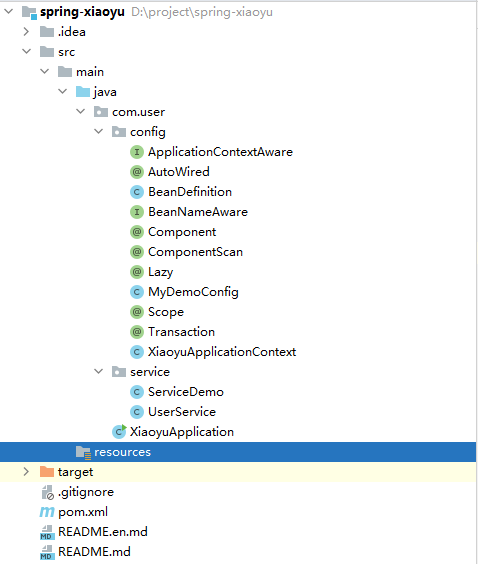Spring源码系列:初探底层,手写Spring
前言
在学习Spring框架源码时,记住一句话:源码并不难,只需要给你各种业务场景或者项目经理,你也能实现自己的Spring。虽然你的实现可能无法与开源团队相媲美,但是你肯定可以实现一个0.0.1版本。因此,初次阅读源码时,不要陷入太深的细节中。先了解大体逻辑,再仔细研读。
实现功能
本文将带领大家实现一个简易版的Spring框架,并介绍以下功能点:
- 了解Spring的底层源码启动过程
- 了解BeanDefinition的概念
- 了解Spring解析配置类等底层源码工作流程
- 了解依赖注入,Aware回调等底层源码工作流程
- 了解Spring AOP的底层源码工作流程
以上功能点将使我们对Spring框架的实现有所了解,但我们并不会一下子实现整个Spring框架的业务。我们将从上述功能点入手,通过手写模拟Spring框架来实现这些功能。
首先,我们像使用Spring一样,传入配置类获取applicationContext,再通过getBean方法获取具体对象。最后,我们调用方法并打印日志。如果你对这些基本流程不熟悉,可以查看我的入门系列文章:Spring入门系列:浅析知识点
详细流程如下:
- 解析配置类上的ComponentScan注解,获取扫描的基本路径
- 开始解析各个被扫描到的文件,是否是需要被Spring管理,如果是则暂存到list集合中
- 开始遍历被Spring管理list集合,解析各个类上的注解,比如是否是懒加载,然后将这些属性都封装到applicationContext中的以beanName为key的BeanDefineMap中
- 针对已经解析好的bean定义进行创建对象并实例化,并将其放入以beanName为key的singletonMap实例化缓存池中。
- 在实例化时,如果发现有依赖注入的对象,则将实例化缓存池中的对象存入。如果缓存池中没有该对象,则进行创建后再注入。
- 判断对象是否实现了各个Aware接口,如果实现,则进行回调。
- 判断对象是否属于增强类。在这里,我们模拟了事务注解。如果有事务注解,则创建一个代理对象,并为所有方法增加拦截器。然后将该代理对象存入单例缓存池中。
详细解析
项目结构
基本路径:com.user目录
各个注解及上下文类:config目录
需要被管理的Bean:service目录
启动类:com.user根目录

源码分析
@Component
public class UserService implements ApplicationContextAware, BeanNameAware {
@AutoWired
ServiceDemo serviceDemo;
private XiaoyuApplicationContext applicationContext;
private String beanName;
public void test() {
serviceDemo.say();
// System.out.println(serviceDemo);
System.out.println("userService:"+applicationContext.getBean("userService"));
System.out.println("beanName:"+beanName);
}
@Override
public void setApplicationContext(XiaoyuApplicationContext applicationContext) {
this.applicationContext = applicationContext;
}
@Override
public void setBeanName(String beanName) {
this.beanName = beanName;
}
}
UserService类主要用于测试是否Spring已经管理了相关对象并生成了代理对象,是我们的日常业务类,我们仔细看下XiaoyuApplicationContext类,主要的流程在这边:
public class XiaoyuApplicationContext {
//配置类
private Class config;
//初始的bean定义
private Map<String,BeanDefinition> beanDefineMap = new HashMap<>();
//单例缓存池
private Map<String,Object> singleBean = new HashMap<>();
public XiaoyuApplicationContext(Class myDemoConfigClass) {
config = myDemoConfigClass;
//解析配置类
scan();
}
public void scan(){
ComponentScan declaredAnnotation = (ComponentScan) config.getDeclaredAnnotation(ComponentScan.class);
String value = declaredAnnotation.basePackages();
doScan(value);
//将bean定义Map生成具体的Bean对象
beanDefineMap.entrySet().stream().forEach(item->{
String beanName = item.getKey();
BeanDefinition beanDefinition = item.getValue();
if (!beanDefinition.isLazy() && "singleton".equals(beanDefinition.getScope())) {
Object bean = createBean(beanName);
singleBean.put(beanName,bean);
}
});
}
/**
* 解析配置类
*/
private void doScan(String value) {
String path = value.replace(".","/");
//正常走文件解析
ClassLoader classLoader = this.getClass().getClassLoader();
URL resource = classLoader.getResource(path);
File file = new File(resource.getFile());
List<File> classFile = new ArrayList<>();
//简单点直接双层解析即可
if (file.isDirectory()) {
for (File f : file.listFiles()) {
if (f.isDirectory()) {
for (File f1 : f.listFiles()) {
if (!f1.isDirectory()) {
classFile.add(f1);
}
}
} else {
classFile.add(f);
}
}
}
//遍历所有解析文件
for (File cFile : classFile) {
String absolutePath = cFile.getAbsolutePath();
String className = absolutePath.substring(absolutePath.indexOf("com"), absolutePath.indexOf(".class"))
.replace("\\", ".");
try {
Class<?> clazz = classLoader.loadClass(className);
//是否需要被Spring管理
if (clazz.isAnnotationPresent(Component.class)) {
//将bean上的注解封装到bean定义中
BeanDefinition beanDefinition = new BeanDefinition();
beanDefinition.setType(clazz);
beanDefinition.setLazy(clazz.isAnnotationPresent(Lazy.class));
if (clazz.isAnnotationPresent(Scope.class)) {
beanDefinition.setScope(clazz.getAnnotation(Scope.class).value());
} else {
beanDefinition.setScope("singleton");
}
String beanName = clazz.getAnnotation(Component.class).value();
if (beanName.isEmpty()) {
//如果不设置beanName会默认生产唯一一个name,Spring底层也是这样做的
beanName = Introspector.decapitalize(clazz.getSimpleName());
}
beanDefineMap.put(beanName, beanDefinition);
}
} catch (ClassNotFoundException e) {
e.printStackTrace();
}
}
}
public Object createBean(String beanName){
BeanDefinition beanDefinition = beanDefineMap.get(beanName);
Class type = beanDefinition.getType();
try {
Object instance = type.newInstance();
//属性填充,依赖注入
populateBean(instance);
if (instance instanceof ApplicationContextAware){
((ApplicationContextAware) instance).setApplicationContext(this);
}
if (instance instanceof BeanNameAware) {
((BeanNameAware) instance).setBeanName(beanName);
}
//是否需要AOP增强
if (type.isAnnotationPresent(Transaction.class)) {
Enhancer enhancer = new Enhancer();
enhancer.setSuperclass(type);
//简单的方法切面
enhancer.setCallback(new MethodInterceptor() {
@Override
public Object intercept(Object proxy, Method method, Object[] objects, MethodProxy methodProxy) throws Throwable {
//开启事务,关闭自动提交
System.out.println("事务已开启");
Object res = method.invoke(instance, objects);
//提交事务
System.out.println("事务已提交");
return res;
}
});
return enhancer.create();
}
return instance;
} catch (InstantiationException e) {
e.printStackTrace();
} catch (IllegalAccessException e) {
e.printStackTrace();
}
return null;
}
private void populateBean(Object instance) {
Field[] declaredFields = instance.getClass().getDeclaredFields();
Arrays.stream(declaredFields).forEach(item->{
//寻找注入点
if (item.isAnnotationPresent(AutoWired.class)) {
Object bean = getBean(item.getName());
item.setAccessible(true);
try {
item.set(instance,bean);
} catch (IllegalAccessException e) {
e.printStackTrace();
}
}
});
}
public Object getBean(String beanName){
if (!beanDefineMap.containsKey(beanName)) {
throw new NullPointerException();
}
if ("singleton".equals(beanDefineMap.get(beanName).getScope())) {
if (singleBean.containsKey(beanName)) {
return singleBean.get(beanName);
} else {
Object bean = createBean(beanName);
singleBean.put(beanName,bean);
return bean;
}
}
return createBean(beanName);
}
}
以上即为整个流程的基本梳理。我们在实现过程中没有涉及Bean循环依赖以及其他各种创建缓存,但Spring在实现Bean的创建过程中确实用到了各种本地缓存和同步锁(synchronized)。在学习源码时,不要太关注这些细节。首先要理解整个流程,再深入研究。
结语
最后,我们在gitee上提供了项目源码。如果需要,可以查看spring-xiaoyu。虽然我认为写一遍自己的代码更好,因为这是最简单的流程,有助于理解Spring源码。
- 点赞
- 收藏
- 关注作者


评论(0)